Table of contents
- Stephen Topham – Grand Master of Mikuni Carburetors The Swiss watch for motorcyclists
- Carburetors are still produced on a large scale
- Mechanical stress is often forgotten
- Conversion to new slide carburetors is worthwhile
- Interview with Stephen Topham
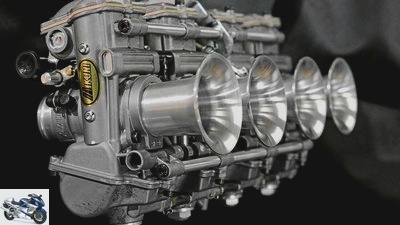
Siemer
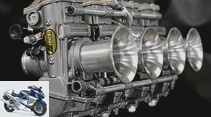
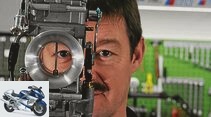
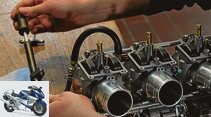
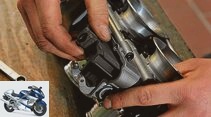
10 pictures
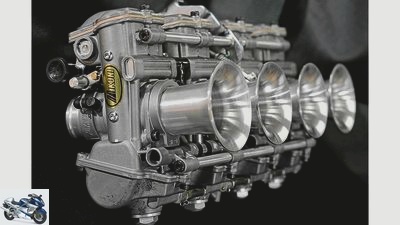
Siemer
1/10
Mixed goods trade: Stephen Topham’s Mikuni carburetors.
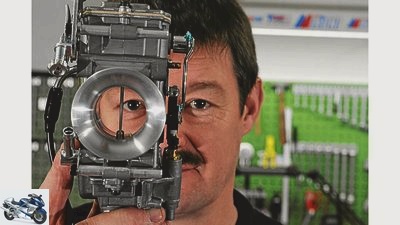
Siemer
2/10
Nobody can fool him when it comes to carburettors: Stephen Topham has had a clear view for 20 years.
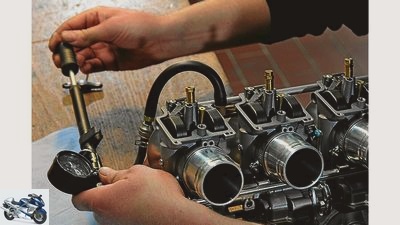
Siemer
3/10
Do the float needle valves hold tight? The pressure test provides unambiguous and quick information.
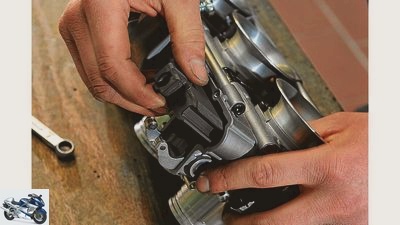
Siemer
4/10
The clear and maintenance-friendly structure characterizes the Mikuni flat slide carburetors, here a TMR battery.
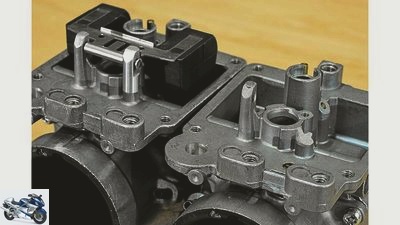
Siemer
5/10
If force is used, the bearing blocks of the float axle break off, but can be repaired.
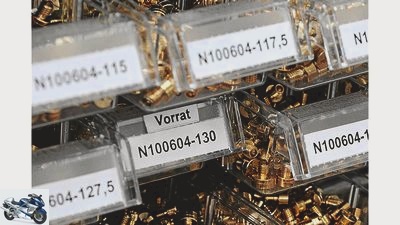
Siemer
6/10
Whether round or flat slide – Mikuni can equip everything from mopeds to Harleys.
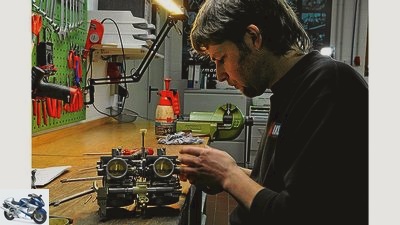
Siemer
7/10
The maintenance of carburettors installed as standard is also part of the Topham carburetor program.
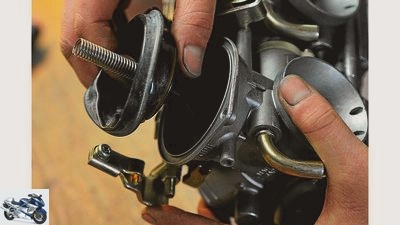
Siemer
8/10
The membranes of the constant pressure carburetors are sensitive to additives and ethanol in gasoline.
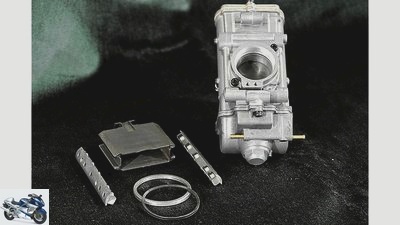
Siemer
9/10
The Mikuni TMR has been the measure of all things for 20 years. Its flat slide is guided by steel rollers.
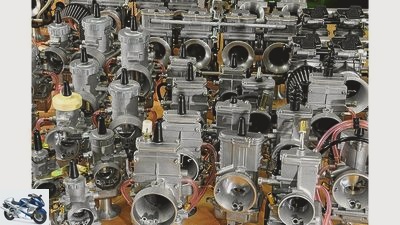
Siemer
10/10
The spare parts situation at Mikuni is relatively relaxed. And with Stephen Topham in the best possible order.
accesories
Grand master for Mikuni carburetors
Stephen Topham – Grand Master of Mikuni Carburetors
The Swiss watch for motorcyclists
Content of
The carburettor needs expert guidance on his way from a commodity to an industrial monument. How good that there is Stephen Topham, one of the last grand masters of pre-electronic mixture preparation.
Fred Siemer
04/17/2013
Some claim that carburetors are a thing of the past. Out of sheer envy, as all friends of well-kept scrap iron know, who happily indulge in the pleasure of fine mechanics, exploring holes, changing nozzles – and unmolested by nasty exhaust gas limits. You don’t need any servomotors, you can still pull the cable properly, use a screwdriver to determine both the idle speed and the mixture composition. And if, in the worst case, you have adjusted everything, the float has a hole and the nozzle needle is bent, then call Stephen Topham in Stemwede. The only requirement for telephone counseling is a motor powered by Mikuni carburetors. The 52-year-old master mechanic has been the German importer of the Japanese carburetor empire since 1994; seven years ago he took over responsibility for all of Europe.
Carburetors are still produced on a large scale
Carburetor production at Mikuni began in 1932 with an Amal license, but such dependencies have long since been overcome: With the triumph of the Japanese motorcycle industry, the Mikuni family business, founded in 1923, also rose to considerable size, was the purveyor to the court at Yamaha and Suzuki, and stocked a number of them Kawasakis. Today’s offer ranges from medical aids to aviation equipment, but the focus is still on components for mixture preparation in cars and motorcycles. Carburetors are also still produced on a large scale.
Stephen Topham’s business rests on three pillars: firstly, he sells aftermarket carburetors, secondly, spare parts for production carburetors, and thirdly, he takes on maintenance work. That means that Stephen and his two assistants, Indra Friehe and Sinja Kirsch, usually do the phone service or arrange the shipping, while the mechanic Sven Lohmeier takes care of the maintenance. Half a dozen carburetor batteries are lined up next to his workbench, neatly stowed in plastic boxes. Some with a list of defects and problems, others with specific instructions. Serial constant pressure carburettors are increasingly found among patients: on the one hand, because they are gradually becoming foreign objects for motorcycle workshops, on the other hand, because friends of youngtimers from half of Europe contact the specialists in northern Germany directly.
Mechanical stress is often forgotten
Such a carburetor usually works without a problem, and the mechanical stress on the slide, nozzle needle or throttle valve shaft is often forgotten. The constant up and down in the nozzle assembly as well as the pulsation of the air in the intake tract put a strain on the brass needle nozzle over the years – the mixture composition gets out of balance. Then there is the increasing chemical load from additives and ethanol admixtures. The membranes in constant pressure carburettors in particular suffer from this, they become brittle and crack. The negative pressure in the diaphragm housing is no longer sufficient to fully ventilate the slide, and the engine output drops.
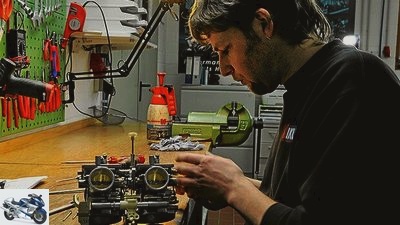
Siemer
The maintenance of standard carburetors is also part of the Topham carburetor program.
But even simple slide carburetors groan under all the chemical stuff: Sven points to the exit area of the needle nozzle, where a little gasoline always remains when the engine is idle. The additives then have all the time in the world to deposit as a sticky edge on the nozzle needle. It can usually be scratched away with a fingernail. What hangs in the holes can only be managed by the ultrasonic device. In the present case, Sven has to replace the needle and nozzle, everything is in the almost unbelievable inventory. It’s as well-organized as the entire workshop, and everything together simply has nothing to do with those casually chaotic workshops that are familiar from the island. Stephen Topham was born in England, but okay, that’s where the most perfect Formula 1 mechanics should come from.
As is well known, most motorcycles of the recent past have constant pressure carburetors, and for the vast majority of all bikers this is a blessing. Even technically ignorant drivers or drivers with a rather gross motor skills can happily crank the throttle without the engine choking, for example, because the throttle valve is torn too abruptly. The smooth transition is done – somewhat sluggishly, but very reliably – the vacuum-controlled membrane on which the throttle valve hangs. The throttle itself is only connected to a throttle valve located behind the throttle slide. However, this disrupts the gas flow and the power output when full pipe is the order of the day. Reason enough to convert all of the racers to flat slide carburettors with better aerodynamics. In the old days, when Stephen Topham also competed in superbike races. His colleagues did not hide the fact that his Yamahas always ran quite well, and so he made other people’s engines for many years. Even today, customers with a sporty feel prefer to use flat slides because they cause less disturbing eddies on their underside than the round ones. The ultimate? Topham hesitates. He knows that a quartet of these gas mixers won’t turn a Bol dOr into a superbike killer. But stronger. Some. And more spontaneous. Clear. In addition, there are many more parts for individual adjustment than with series carburetors; this pays off when experimenting with air filters, intake funnels or exhausts.
Conversion to new slide carburetors is worthwhile
Finally, and this should be emphasized here, such a Bol dOr is more beautiful. The set configured and tuned at Topham consists of four Mikuni TMR carburetors. Very compact housing, discreetly connected to form a perfectly spaced and functioning battery. Irresistible. You want to touch them. Only this way. Operate the slide shaft and watch the absolutely synchronous up and down of the four flat slides. It is so full and creamy, and that in turn is no wonder, because both the slides and their levers are guided by tiny steel rollers. Mechanics in top form, the Swiss watch for motorcyclists. Nobody has to ask about the dull benefits, such carburettors simply produce added value by themselves.
Sometimes these things even save money: the carburetors of many older series motorcycles have long been out of production. Spare parts are rare and expensive, not to mention the housings that can be needed to get a barn find back into operation that has been forgotten for years. Then it is worth retrofitting to new slide carburettors. This problem will be exacerbated when the last carburettor engines get into the maintenance-intensive age. They often carry exclusive downdraft carburetor batteries, tailor-made for the narrow space between the frame, air filter housing and engine. Although the last flat slide development from Mikuni, the TDMR, also works as a downdraft carburetor, Stephen fears that there will not be enough space everywhere for a replacement solution. That in turn may not matter to friends of well-kept scrap iron. Even today. But at some point CBR, R1 or GSX-R will also be included. To the old iron.
Interview with Stephen Topham
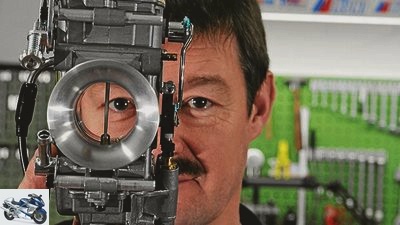
Siemer
Nobody can fool him when it comes to carburettors: Stephen Topham has had a clear view for 20 years.
The Mikuni importer Stephen Topham sells retrofit carburetors and spare parts for a large number of standard Mikuni carburettors.
Let’s pay too little attention to our carburettors?
No, no, a well-adjusted carburetor will do with a little attention. Of course, the carburetor can always be to blame if the performance deteriorates. But usually a longer process is responsible for it, and it almost always starts with increasing consumption. I recommend checking the consumption regularly under comparable conditions.
And when it has risen?
The exact cause can be determined with a simple CO measurement. The main suspects are initially – assuming the correct setting and, if necessary, an intact air filter – the nozzle needle and needle nozzle, also known as the nozzle holder.
What are the most common setting errors??
Carburetors are often set unnecessarily bold. Each cylinder should be set and checked individually for idling and partial load. Often the CO screw with its very fine thread is turned too tightly against the housing during the basic setting. This can damage the hole or even cause the tip of the screw to shear off when loosened.
And where does the carburetor have its most common weak points?
The constant movement of the gas slide and the pulsation of the air in the intake tract put a strain on components such as the nozzle needle and needle nozzle as well as the gas slide and the gas slide guide. Float needle valves wear out due to mechanical contact. Throttle valve diaphragms develop cracks over time due to the additives and the admixture of ethanol, then the gas valve cannot be raised according to the load.
But now: How can you take care of the carburetor??
It is very important to drain the petrol when the vehicle is parked for two to three months. Not
simply run the float chamber empty, because then there will still be gasoline in it. I even recommend leaving the drain plug open for a while to allow the carburetor to ventilate well. In addition, of course, no petrol must run out of the petrol tap.
Why is it so bad when gasoline stays in the carburetor?
The deposits that inevitably get stuck in the carburetor and in the nozzles mean that the carburetor usually has to be completely dismantled and cleaned.
Back to care. Is there a standard distance that carburetors should be inspected?
No. And there is no reason to dismantle the carburetor if the CO value is correct when idling, the carburettors can be synchronized, the mechanics work perfectly (engine returns to idle immediately after accelerating), consumption has not increased, none There are leaks and the top speed is reached.
And when the time comes: How do you proceed??
Carefully and systematically, with space for neat storage of the many small parts. When dismantling, pay attention to damage such as defective threads, sheared CO screw tips, torn or broken float bearing blocks, defective membranes. After the float chambers have been dismantled, the float needle valves can be subjected to a low-pressure test. In the event of a leak, it is easy to determine with a little liquid whether the seat or just the seal is defective. The completely dismantled carburetors are cleaned in an ultrasonic bath. During assembly, all rubber seals and O-rings should be replaced, original Mikuni rubber seals made of Viton offer the necessary resistance to today’s fuels. If the anodized layer of the nozzle needle is not damaged (polished areas), it can be used again. The brass needle nozzle wears out faster, so I usually recommend replacing it as a precaution. Mikuni needle nozzles are manufactured with a maximum tolerance of 0.002 millimeters. Enlarging the bore by 0.02 millimeters due to wear and tear can quickly increase consumption by 1 to 1.5 liters! After assembly, check the float needle valves again for leaks and adjust the float levels to the factory specifications by bending the tongue on the float arm – without compressing the small damping spring in the float needle. Finally, make the basic setting of the mixture screws.
Are the spare parts still available in their original quality??
I can only judge that for Mikuni carburetors, and it still looks good there. But even with us, more and more carburettors and, inevitably, their spare parts, too, are falling out of our range. Where it is worthwhile, I have had Mikuni reproduced it, for example for carburetors for two-stroke engines from the early boom years. If the parts are missing, the only thing that helps is retrofitting to other carburettors: We now deliver a lot to customers who can no longer repair their original – regardless of the manufacturer.
What is the legal side of a retrofit??
We have had some TuV reports drawn up for our retrofit carburettors. But such a complex and expensive thing is only worthwhile for certain volume models. On the other hand, we experience that the inspectors are quite accessible when a good and well-adjusted carburetor is to be registered on older vehicles.
Related articles
-
Jahn motorcycles Master Crosss 2004 Master Crosss 2004 High-flyer wanted Eight journalists from the most important magazines in Europe are testing 24…
-
Jahn motorcycles Master Enduro 2005 Master Enduro 2005 Top candidacy 31 machines competed for the title of the best sport enduro of the year 2005. The…
-
Schoch 49 pictures Schoch 1/49 If the engine does not immediately idle when you let go of the throttle grip, the ability of the throttle cable to operate…
-
Carburetor functionality in the video
Smartereveryday 49 pictures Schoch 1/49 If the engine does not immediately idle when you let go of the throttle grip, the ability of the throttle cable…
-
Jahn motorcycles Master Bike 2006 Master Bike 2006 Everything is possible Let the fastest win: this is the motto under which the top athlete of her year…
-
motorcycles Master Bike 2001 Master Bike 2001 Vamos a bailar “Let’s dare to dance!” Our Spanish colleagues asked us and asked six other nations to come…
-
Jahn motorcycles Master Enduro 2003 Master Enduro 2003 The party of the year When Europe’s off-road testers invite you to a big party, you have to expect…
-
motorcycles Master Bike 2003 Master Bike 2003 Fox hunting Upside down world: When the best production motorcycles meet at the annual hunt after the…
-
motorcycles Master Bike 2002 Master Bike 2002 The need for speed Twelve testers from eleven countries have only one thing in mind for the world’s largest…
-
Isle of Man – Manx Grand Prix and Classic TT 2014
Jahn 40 pictures Jahn 1/40 Isle of Man – Manx Grand Prix and Classic TT 2014. Jahn 2/40 Isle of Man – Manx Grand Prix and Classic TT 2014. Jahn 3/40 Isle…